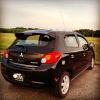foama - I do not believe that is correct. Not at all. And, you're making BIG assumptions. And I don't believe your assumptions are correct. And besides, I don't think the 1st O2 sensor is the issue with the Check Engine light that dikulus is getting. I don't remember if it was this forum that mentions this. But (as I understand, granted I might be wrong), the 1st sensor is reporting AFR (oxygen) data to the ECU. The 2nd sensor is reporting probably oxygen data to the ECU ... but that signal is used in order to confirm catalyst performance. Therefore it should be the 2nd sensor that is the issue at hand. I'm probably making assumptions too. For one thing, I'm only referring to Mirages that run 2 O2 sensors. dikulus and Basics are those.
Don't misunderstand me. I don't think you're dumb. Quite the opposite. I just don't believe you're correct in this case. There are a lot of reasons why I don't think your assumption is correct. I actually run an AFR gauge. It is probably as high tech, possibly more so, as what is used by OEMs. It is attached to one collector on my V8 engine. Both sides have a bung and I can switch sides. It is MORE THAN capable on just the one side.
However, why I think your assumption is wrong is because, outside of actual design work, the 2nd leading amount of time spent as a design engineer is VA/VE or cost out. Every OEM will push their engineers to make everything on the car as inexpensive as possible. In turn, design teams will push tier 1's (suppliers, like NGK, Denso, etc) to do the same thing. Tier 1's will have maybe as much as quarterly, but at minimal once a year reviews with OEM engineers to review every possible idea and variation of the products they supply to said OEM, to reduce cost. These reviews are detailed down to dissecting a gnat's anus. I disliked these efforts. Too time consuming, for small reductions. But across thousands of parts, the reductions can be quite substantial. So it is always a big effort. The point being, if slowing down the sampling rate in some way reduces cost but continues to provide enough sampling to run well, the sampling rate will be slowed to minimal. I'm not saying that's the case, I don't actually know, it's an example.
I'm not saying an OEM O2 sensor cannot "sniff" every puff, it could likely take multiple samples per exhaust stroke. And heckfire, if you place it in a manifold where all cylinders' exhaust accumulate, how would it then distinguish between the 3 individual "puffs?" They blend. What I am saying is that it is not necessary to do so in order to gain the data needed in order to run properly. Perhaps it's sampling more than every individual exhaust stroke, perhaps it's sampling less. Its sampling at whatever rate the sensor is rated to sample, based on meeting lifecycle (warranty) requirements and cost standards. Automotive engineering is VERY complex. Decisions about how to design and solve problems are sometimes based on the most UNobvious reasons. Been through MANY decision meetings at Toyota and those meetings were a REAL eye opener. Much respect to the Toyota process of making design decisions. Hyundai simply makes decisions on how much things are like Toyota and, hey it's 1 cent cheaper, do it.
Basic - I sent dikulus a PM asking exactly what error codes he sees. I didn't send you one because, I guess I've missed where you mentioned your set up. As I recall you purchased ... drawing a blank, major contributor here / previous autocrosser, his blue Mirage. Now your blue Mirage (3 pedals, no cruise control).
However, if you don't mind telling me your setup, and what codes you see (dikulus too), we can go from there and see what we can learn. There is a solution. Will we find it? Dunno. It may be too complex and/or too expensive.
__________________________________________
 View my fuel log 2020 Mirage ES 1.2 manual: 42.4 mpg (US) ... 18.0 km/L ... 5.5 L/100 km ... 51.0 mpg (Imp)
View my fuel log 2020 Mirage ES 1.2 manual: 42.4 mpg (US) ... 18.0 km/L ... 5.5 L/100 km ... 51.0 mpg (Imp)


 Marshmellow
Marshmellow
 Reply With Quote
Reply With Quote
 Ghost
Ghost Onyx
Onyx



 Blueberry
Blueberry Basic
Basic

